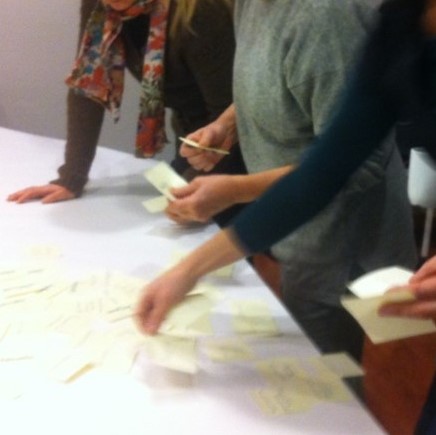Editorial Essay. The research group Embodied Making and Learning at the University of South-Eastern Norway
DOI:
https://doi.org/10.7577/formakademisk.5186Keywords:
Embodied Making and Learning (EMAL)Abstract
There is no one history of the research group Embodied Making and Learning (EMAL). EMAL is an interdisciplinary research group that addresses the phenomenon of embodied making and learning. We work together to achieve three main aims: to enhance quality in our research, to further community and cooperation between researchers, and to contribute to developing our field nationally and internationally.
References
AECEA, P. E. (2009). Arts and cultural education at school in Europe. Education, Audiovisual and Culture Executive Agency. http://eacea.ec.europa.eu/education/eurydice/documents/thematic_reports/113EN.pdf
Bamford, A. (2006). The wow factor: Global research compendium on the impact of the arts in education. Waxmann.
Bamford, A. (2012). Arts and cultural education in Norway 2010-2011. http://www.kunstkultursenteret.no/sites/k/kunstkultursenteret.no/files/1f0ba571783fe8dc31a13ac76d5f196a.pdf
Bammer, G. (2013). Disciplining interdisciplinarity. Integration and implementation sciences for reseaching complex real-world problems. Australian National University E-press. https://doi.org/10.26530/OAPEN_459901
Bruner, J. S. (1960). The process of education. Harvard University Press.
Dunin-Woyseth, H., & Michl, J. (2001). Towards a disciplinary identity of the making professions: The Oslo millennium reader. Oslo School of Architecture.
EMAL HiT. (2015a). Deltakergrupper innenfor Forskergruppen EMAL September 26 2015.
EMAL HiT. (2015b). Embodied making and learning research group. Høgskolen i Sørøst-Norge.
EUC. (2007). Conclusion of the Council and of the Representatives of the Governments of the Member States, meeting within the Council of 15 November 2007, on improving the quality of teacher education. Council of the European Union. http://eur-lex.europa.eu/LexUriServ/LexUriServ.do?uri=OJ:C:2007:300:0006:0009:EN:PDF
European Commission. (2013). Education and training in Europe 2020: Responses from the EU member states. Eurydice.
Forvaltningsdatabasen. (u.å). Statens lærerskole i forming, Notodden - Endringshistorie. Norsk Samfunnsvitenskapelige Datatjeneste, NSD. https://www.nsd.no/polsys/data/forvaltning/enhet/21660/endringshistorie
Gibbons, M., Limogens, C., Schwartzmann, S., Scott, P., & Trow, M. (1994). The new production of knowledge: The dynamics of science and research in contemporary societies. Sage.
Gibbons, M., & Scott, P. (2001). Re-thinking science. Knowledge and the public in an age of uncertainty. Polity Press.
Gulliksen, M. S. (2003). Finnes det en teoretisk drøftingstradisjon innen mitt fagfelt? In J. Sandven (Ed.), Fagkultur og kernefaglighed. Dokumentasjon fra NordFo-symposium Fredriksberg Seminarium 2.-6. oktober 2002 (B:12 ed., Vol. 2003, pp. 160–179). NordFo.
Gulliksen, M. S. (2014). Beredskapskunnskap - navet i lærerutdanning i Kunst og håndverk. FORMakademisk, 7(5), 1–19. https://doi.org/10.7577/formakademisk.902
Gulliksen, M. S., & Hjardemaal, F. R. (2016). Choosing content and methods: Focus group interviews with faculty teachers in Norwegian pre-service subject teacher education in design, art and crafts. Scandinavian Journal of Educational Research, online first, 3. November, 2014(1/2016). https://doi.org/10.1080/00313831.2014.967809
Gulliksen, M. S., & Homlong, S. (2013). Editorial, making, materiality, and knowledge. FORMakademisk, 6(2). https://doi.org/10.7577/formakademisk.649
Høgskolen i Telemark. (2013). FOU-SAK 33-13 Tiltak for å øke eksterne inntekter.
KEA European Affairs. (2009). The impact of culture on creativity. European Commission (Directorate-General for Education and Culture). https://keanet.eu/wp-content/uploads/2019/09/impactculturecreativityfull.pdf
Kjosavik, S. (1998). Fra ferdighetsfag til forming : utviklingen fra tegning, sløyd og håndarbeid til forming sett i et læreplanhistorisk perspektiv [From a skill subject to Forming]. [Dr. thesis, Det utdanningsvitenskapelige fakultet, Universitetet i Oslo]. https://www.nb.no/search?q=oaiid:%22oai:nb.bibsys.no:999900829544702202%22&mediatype=b%C3%B8ker
Litt, T. (1949). Führen oder Wachsenlassen. Eine Erörterung des Pädagogischen Grundproblemes. Verlag von Ernst Klett.
Meld. St. 18 (2014-2015). Konsentrasjon for kvalitet — Strukturreform i universitets- og høyskolesektore. https://www.regjeringen.no/no/dokumenter/meld.-st.-18-2014-2015/id2402377/
NOKUT. (2015). Akkreditering som universitet — Veiledning for institusjoner som søker akkreditering som universitet. NOKUT.
Nyzell, S. (forthcoming). Grendels Skatt - Återskapad tidig medeltid och gränslanden mellan historia, sanning och fiktion.
Research Council of Norway. (2018a). Evaluation of Norwegian education research. Report from the International Expert Committee Final Report 22 February 2018. https://www.forskningsradet.no/om-forskningsradet/publikasjoner/2018/evaluation-of-norwegian-education-research/
Research Council of Norway. (2018b). Institutional feedback from the evaluation committee - University College of Southeast Norway, HSN.
Winner, E., Goldstein, T. R., & Vincent-Lancrin, S. (2013). Art for art's sake? The impact of arts education. OECD - Centre for Educational Research and Innovation. https://doi.org/10.1787/9789264180789-en

Downloads
Published
How to Cite
Issue
Section
License
Copyright (c) 2023 Marte S. Gulliksen

This work is licensed under a Creative Commons Attribution-NoDerivatives 4.0 International License.
Authors who publish with this journal agree to the following terms:
- Authors retain copyright and grant the journal right of first publication with the work simultaneously licensed under a Creative Commons Attribution 4.0 License that allows others to share the work with an acknowledgement of the work's authorship and initial publication in this journal.
- Authors are able to enter into separate, additional contractual arrangements for the non-exclusive distribution of the journal's published version of the work (e.g., post it to an institutional repository or publish it in a book), with an acknowledgement of its initial publication in this journal.
- Authors are permitted and encouraged to post their work online (e.g., in institutional repositories or on their website) prior to and during the submission process, as it can lead to productive exchanges, as well as earlier and greater citation of published work (See The Effect of Open Access).
- The author(s) must manage their economic reproduction rights to any third party.
- The journal makes no financial or other compensation for submissions, unless a separate agreement regarding this matter has been made with the author(s).
- The journal is obliged to archive the manuscript (including metadata) in its originally published digital form for at least a suitable amount of time in which the manuscript can be accessed via a long-term archive for digital material, such as in the Norwegian universities’ institutional archives within the framework of the NORA partnership.
The material will be published OpenAccess with a Creative Commons 4.0 License which allows anyone to read, share and adapt the content, even commercially under the licence terms:
This work needs to be appropriately attributed/credited, a link must be provided to the CC-BY 4.0 licence, and changes made need to be indicated in a reasonable manner, but not in any way that suggests that the licensor endorses you or your use.



